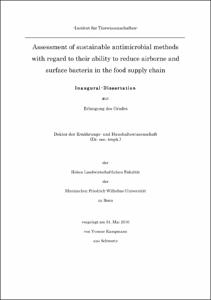Kampmann, Yvonne: Assessment of sustainable antimicrobial methods with regard to their ability to reduce airborne and surface bacteria in the food supply chain. - Bonn, 2010. - Dissertation, Rheinische Friedrich-Wilhelms-Universität Bonn.
Online-Ausgabe in bonndoc: https://nbn-resolving.org/urn:nbn:de:hbz:5N-22119
Online-Ausgabe in bonndoc: https://nbn-resolving.org/urn:nbn:de:hbz:5N-22119
@phdthesis{handle:20.500.11811/4218,
urn: https://nbn-resolving.org/urn:nbn:de:hbz:5N-22119,
author = {{Yvonne Kampmann}},
title = {Assessment of sustainable antimicrobial methods with regard to their ability to reduce airborne and surface bacteria in the food supply chain},
school = {Rheinische Friedrich-Wilhelms-Universität Bonn},
year = 2010,
month = jul,
note = {The objective of this thesis was the assessment of antimicrobial methods with regard to their ability to reduce airborne and surface bacteria during processing and storage of perishable food. In particular, possible influencing factors on the rate of antimicrobial activity were investigated, such as temperature, food residuals and microflora. Based on the results, an evaluation scheme was developed for the assessment of antimicrobial techniques with regard to the prevailing requirement profiles for the respectively application area.
The study focuses on the application of materials containing silver for reduction of surface bacteria and on the use of ionization for the reduction of surface and airborne bacteria.
For the determination of the influence of selected factors on the antimicrobial activity of these both techniques (materials containing silver and ionization) the standard test procedure JIS Z 2801 (2000) was used in a modified form. By comparing colony forming units under the influence of the antimicrobial technique with the colony forming units at reference conditions, the rate of antimicrobial activity was determined.
It became apparent, that both of the techniques examined were generally able to reduce surface and airborne bacteria. However, the rate of reduction was strongly dependent on the influencing factors of time, temperature, and the sensitivity of test organisms used as well as on the effect of possible food residuals on the surface. Thus, the application of the described techniques in contact with perishable food is only beneficial, if the available microbiological, material and environmental factors fit to the activity profile of the antimicrobial technique. Based on the results, an evaluation scheme was developed for the testing of antimicrobial methods as to their applicability for use in the food chain. The scheme gives priority to the integration of the influencing factors - material, microbiology and environment.},
url = {https://hdl.handle.net/20.500.11811/4218}
}
urn: https://nbn-resolving.org/urn:nbn:de:hbz:5N-22119,
author = {{Yvonne Kampmann}},
title = {Assessment of sustainable antimicrobial methods with regard to their ability to reduce airborne and surface bacteria in the food supply chain},
school = {Rheinische Friedrich-Wilhelms-Universität Bonn},
year = 2010,
month = jul,
note = {The objective of this thesis was the assessment of antimicrobial methods with regard to their ability to reduce airborne and surface bacteria during processing and storage of perishable food. In particular, possible influencing factors on the rate of antimicrobial activity were investigated, such as temperature, food residuals and microflora. Based on the results, an evaluation scheme was developed for the assessment of antimicrobial techniques with regard to the prevailing requirement profiles for the respectively application area.
The study focuses on the application of materials containing silver for reduction of surface bacteria and on the use of ionization for the reduction of surface and airborne bacteria.
For the determination of the influence of selected factors on the antimicrobial activity of these both techniques (materials containing silver and ionization) the standard test procedure JIS Z 2801 (2000) was used in a modified form. By comparing colony forming units under the influence of the antimicrobial technique with the colony forming units at reference conditions, the rate of antimicrobial activity was determined.
It became apparent, that both of the techniques examined were generally able to reduce surface and airborne bacteria. However, the rate of reduction was strongly dependent on the influencing factors of time, temperature, and the sensitivity of test organisms used as well as on the effect of possible food residuals on the surface. Thus, the application of the described techniques in contact with perishable food is only beneficial, if the available microbiological, material and environmental factors fit to the activity profile of the antimicrobial technique. Based on the results, an evaluation scheme was developed for the testing of antimicrobial methods as to their applicability for use in the food chain. The scheme gives priority to the integration of the influencing factors - material, microbiology and environment.},
url = {https://hdl.handle.net/20.500.11811/4218}
}






